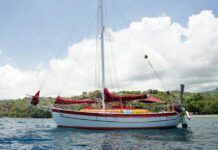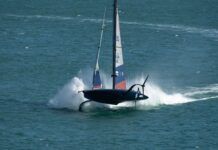A flashlight on a boat is a necesity. Some owners we know carry drawers full of them. Seems you can’t have too many.
We bought eight flashlights to test from marine and hardware stores and from catalogs. Choices were limited to conventional models, which use easy-to-find C- and D-cell batteries. Some of the advanced types of bulbs, however, may not be as easy to find.
The flashlights tested can be divided into three categories: household, industrial, and law enforcement, ranging from $7.99 to $44.99. Only one was specifically advertised for boating and another was intended for underwater work.
We judged the flashlights according to their ease of use, illumination and durability.
Ease of Use: We tested for battery loading and bulb changing in both dim light and no light. We checked the grip and switch when dry, wet and coated with cooking oil. Hands-free operation was tested by placing the light on a smooth surface at an angle of up to 30. All of the models had good balance when held.
Illumination: We used the flashlights to distinguish details 200′ away on a chain-link fence and the bleachers of a school playing field. We observed the beam-focusing qualities.
Durability: The lights were immersed in 2′ of water for two hours and then opened to check for moisture. Each light was dropped twice from 5′, switch and lens downward. We then immersed them again for one hour.
Rayovac Workhorse
The Workhorse, constructed mainly of heavy plastic, is a household type and takes two D-cells. The model we tested was difficult to load. First, the lens/reflector/bulb assembly that unscrews only extended a 1/2″ from the barrel of the light, and even with a rubber coating it was hard to grip when dry and next to impossible when wet. Second, once the batteries were loaded, the combination of a powerful spring and shallow threads made it difficult to seat and engage the lens assembly properly, even in full light. The bulb was easy to change through a screw cap in back of the reflector.
The switch was confusing because it looked like a push-button but was really a slider. The switch itself was smooth and slightly dome-shaped, offering little friction to the thumb. The barrel has fairly deep grooves that offer a decent grip when dry and wet, but not when covered with even a thin film of oil.
The Workhorse, a cylinder with no flat surfaces, tended to roll at even slight angles. It has a Krypton bulb that the manufacturer says gives a 200% brighter beam. But most of the brightness seemed to be lost in halation (concentric circles of light around the central beam), and the central beam itself was small and diffused. At 200′ we could barely distinguish any details on the test fence. At 100′ it was slightly better.
This light is not waterproof. After five minutes immersed, bubbles started coming from the area of the switch. When opened, a small quantity of water poured out. The drop test was more successful, with no visible damage after four drops. There’s no lanyard or place to secure one.
Eveready Halogen
Although a household flashlight, the Eveready Halogen has some features that could make it acceptable for boat use. The Halogen, constructed of heavy plastic, uses two D-cells. The head has two separate components: the lens/reflector/bulb assembly and the switch assembly. When unscrewing, we had to grasp the head around the switch rather than the lens to reach the battery compartment. Changing the bulb involved gently prying a soft plastic nipple that surrounds the bulb away from the back of the reflector-we preferred the Rayovac screw cap assembly.
The Halogen has a large rubberized push-button switch protected by a low circular barrier that makes the switch easy to find on the smooth surface. It was also easy to operate. The barrel is slightly conical, tapering toward the butt. It has a slightly rough surface that felt somewhat slippery when dry, much more when wet, and hard to hold when coated with oil.
Compared to the Rayovac, the Halogen has a bright central beam with little halation. It picked out details on the test fence at 200′ and passed both the immersion and drop tests but failed to float.
Garrity Tuff Lite
The Garrity Tuff Lite is an industrial flashlight. It is a plastic cylinder armored with black rubber and takes two D-cells. Loading is done simply by unscrewing the head and dropping in the batteries. The armor on the head tended to slide a bit when twisted too tightly. A screw assembly in back of the reflector holds the bulb, and changing it was simple.
Rubber armor covers the push-button switch. We saw the position of the switch, at the base, as a possible problem. It ‘s unconventional, which might make it difficult to find by someone unfamiliar with it. And it really required two hands to turn the light on-a problem. When on, a slight pressure on the switch (using two hands) allowed for signaling pulses.
The knobby rubber armor made for an excellent grip when dry, good when wet, and very reasonable when oiled. The Tuff Lite has a slight projecting flat surface 1-1/4″ wide near the head. The wrist strap at the base would allow the light to be hung over a work area. Its bright central beam had little halation. Details of the test fence and bleachers were visible at 200 feet.
When immersed, the Tuff Lite floated with the lens up. It is advertised as being water-resistant rather than waterproof, and we found this to be true. After its dunking we found small beads of moisture around the threads and in the interior. After the drop test we discovered a crack across the side of the lens, though the lens itself remained intact.
Dorcys The Boss
We like this industrial light the best overall because it had the most advantages and fewest drawbacks. Like the Garrity, it is a rubber-armored plastic cylinder. Loading the D-cells was no problem. The bulb is changed via a screw cap in back of the reflector.
The push-button switch is covered by the rubber armor and mounted near the head on a 1/2″-high projection that runs most of the length of the barrel. Though only 1/2″ wide, it was easy to locate because of its positioning. When the light was on, a slight pressure on the switch allowed for pulsing. The rubber armor offers an excellent grip when dry, good when wet, and fair when oiled. It comes with a wrist strap attached to the base.
We liked the quality of The Bosss beam. Unlike most of the other lights with smooth reflector surfaces, the Bosss reflector is faceted, which made for a solid beam with almost no halation or unevenness due to filament reflection. Details of the test fence and bleachers were visible at 200′.
The Boss floated lens up. When we opened it after immersion we found no moisture. When dropped, the tightening collar on the wrist strap shattered, but the collar didnt come undone. The light itself was not affected by the drops and second immersion.
Pelican ProLite 4C
The ProLite 4C straddles the line between the industrial and law enforcement categories. We werent pleased with the model we tested for use on a boat. As its name implies, it uses four C-cells. Batteries were easily loaded through the base and the spring was firmly attached to the base cap, which was not the case in other base-loading lights we tested. Changing the bulb was a different story. The head assembly required some force to unscrew, and we found the reflector not attached to the head. The Xenon bulb has three thin prongs that have to be fitted into three small holes-not easy even in good light.
One of its claims is its dual filament, which allows you to switch from one filament to another using one bulb.
The ProLite has a switch arm mounted parallel to the barrel that allowed for both pulses and full illumination when pushed in either direction. At least thats the theory. On the model we tested, the pulse function worked well on either side but getting to the full on positions was such a struggle that at one point we were afraid the plastic switch arm might break. Initially, getting the switch to the on position on both sides required two hands, one to steady the light while the other forced the switch to cooperate.
After about 20 tries in both directions to see if we could loosen it a bit, it would neither pulse nor turn on when pushed to the right, and there was no pulse function when pushed left. Then a few minutes later, everything worked again.
The ProLite has a reasonable grip when dry, and a fair grip when wet or oiled. It has a wrist strap.
The ProLite is advertised as having a quick focusing beam, but we noticed little difference in light concentration. The light seemed to be in permanent diffused mode with considerable halation. We were able to make out some details at 200′ but did better at 100′. The ProLite is advertised as submersible to 500′. After immersion the interior was dry as a bone. After dropping we noticed a number of silver flakes from the surface of the reflector on the lens.
Legend Three C-Cell Size
The Legend, made of machined aluminum with a black anodized finish and rubber gripping surfaces on the barrel and head, felt and worked as solid as it looked.
Its C-cell batteries were easily loaded through the base. Care has to be taken, though, because the spring is not attached to the base and could fall out if not seated properly. A brass sleeve (we had difficulty gripping it until we got the hang of it) encloses the bulb. The switch is a rubberized push-button recessed in the barrel. When off, a slight finger pressure sent pulses. The grooved rubber surface had an excellent grip when dry, good when wet, and reasonable when oiled.
The Legend is a cylinder with little provision for hands-free work. When focused, the beam was well concentrated with almost no halation. A full turn of the head gave a good diffused beam, and a further turn diffused it even more. It was effective at 200′. The Legend took its 5′ drops like a piece of pipe and worked perfectly.
We found no moisture after the immersion test.
Mag-Lite Master Electrician
The Mag-Lite is similar to the Legend, except that the Mag-Lites gripping surface consists of cross-hatches machined onto the aluminum barrel instead of the Legends rubber grip (which we liked better). The two D-cells are loaded in the base. We had to use caution to make sure the spring was seated in the base cap. Like the Legend, the Mag-Lites bulb is encased in a brass sleeve.
The switch is a rubberized push- button recessed in the barrel. When the light is off, slight finger pressure activated pulses. The grip was very good when dry, good when wet, and reasonable when oiled. It has no provision for hands-free operation and no place to attach a lanyard. Its beam focused well. A 3/4 turn on the head gave a good level of diffusion, and it passed our 200′ test. There was no moisture in the interior after immersion, and it shrugged off the drop test.
Pelican Super PeliLite
This was the one flashlight in our group recommended for boats. In terms of size, the PeliLite is the runt of the litter, but several of its features make it a winner.
Made of heavy plastic, the PeliLite takes two C-cells, loaded easily through the head. The small Xenon bulb is part of a bulb/reflector module that is changed together. This is good in terms of ease, but may be difficult in terms of quickly finding a replacement module. Twisting the head turns it on. It required two hands, but the action was so quick and decisive we didnt see it as much of a problem.
This flashlight is so light you almost have to look to be sure its in your hand. The grip was good when dry, reasonable when wet, and fair when oiled. It has two wings on the sides with a slot that could take a strap, and a wrist strap for hanging.
Given its size, we were impressed with the PeliLites light-throwing ability. The beam, though small, was well-concentrated with little halation. Test objects were visible at 200′ and well-defined at 100′. Its advertised as submersible to 500′. After immersion the interior was perfectly dry. The drop tests didnt faze it.
Conclusions
In a hierarchy of choice, we recommend Dorcys The Boss and the Pelican Super PeliLite, but we also like the Mag-Lite Master Electrician, Garrity Tuff Lite and Legend.
Contacts- Rayovac Corp., 601 Rayovac Drive, Madison WI 53711; 608/275-3340. Eveready Battery Co., 800 Chouteau Ave., St. Louis, MO 63164; 314/982-2000. Garrity Industries, 14 New Road, Madison, CT 06443; 203/245-8383. Dorcy Int., 720 Port Rd., Columbus, OH 43217; 614/497-5830. Pelican Products, 23215 Early Ave., Torrence, CA 90505; 800/473-5422. The Keller Company (Legend), 1204 W. 27th St., Kansas City, MO 64108; 816/753-7343. MAG Instrument, Box 50600, Ontario, CA 91761-1083; 909/947-1006.








































